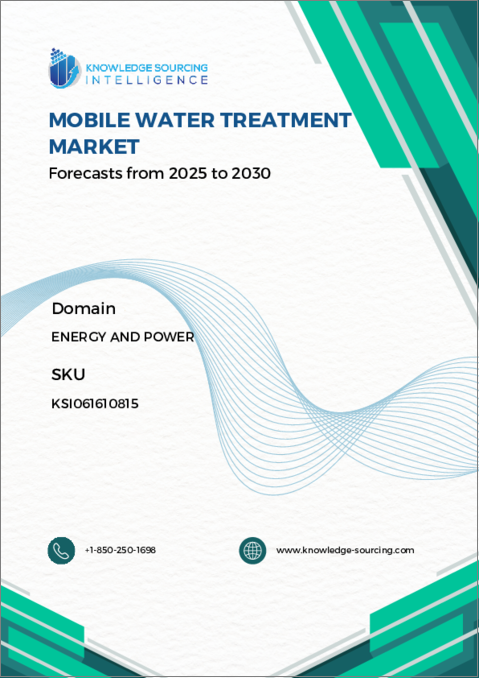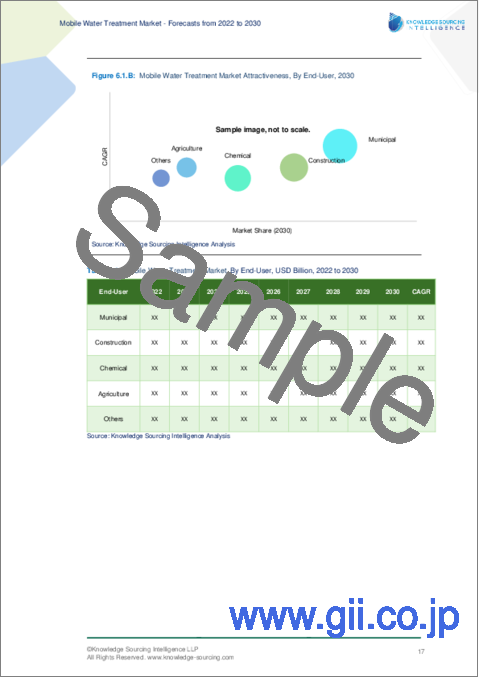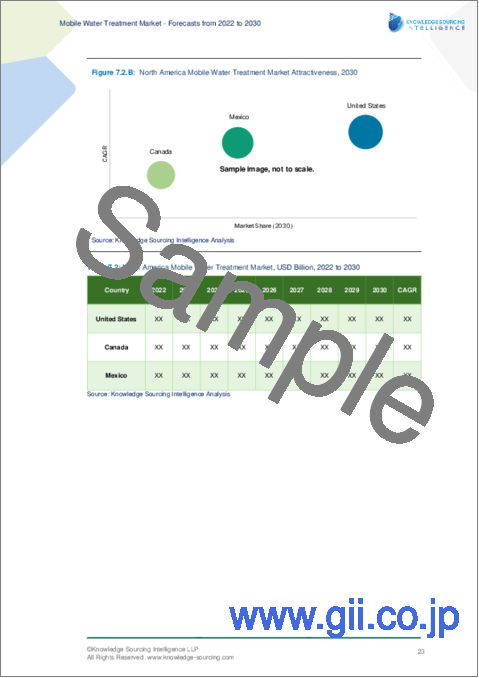|
|
市場調査レポート
商品コード
1627796
移動式水処理の世界市場:予測(2025年~2030年)Global Mobile Water Treatment Market - Forecasts from 2025 to 2030 |
||||||
カスタマイズ可能
|
|||||||
| 移動式水処理の世界市場:予測(2025年~2030年) |
|
出版日: 2024年12月18日
発行: Knowledge Sourcing Intelligence
ページ情報: 英文 144 Pages
納期: 即日から翌営業日
|
全表示
- 概要
- 目次
移動式水処理市場は、2025年の24億1,000万米ドルから、2030年までには42億7,800万米ドルへとCAGR12.16%で成長すると予測されています。
移動式水処理システムは、安全な飲料水を定期的に供給するため、水供給サービスが一時的に中断した場合に使用されます。海水、地表水、海水、池、河川など、あらゆる自然の水源から、移動式処理ソリューションによって浄化された水を作り出すことができます。水質汚染事故は世界中で増加傾向にあり、これが世界の移動式水処理市場の主な原動力となっています。さらに、淡水資源の縮小や乾燥地域での水不足は、世界市場の拡大に大きな影響を与えています。しかし、市場の開拓は、移動式水処理ソリューションの製造コストと導入コストによって妨げられる可能性があります。
移動式水処理市場の促進要因
- 貯水池と処理場建設の増加
世界の貯水池や廃水・水処理プラントの急速な拡大は、移動式水処理市場の成長を後押しする主な要因の1つです。水不足は多くの国で深刻な問題となっており、清潔な水への需要が高まっています。淡水資源は急速に枯渇しています。米国食糧農業機関は、2025年までに19億人が完全に水不足の地域に居住するようになると予測しています。さらに、2025年までに世界人口の約3分の2が水不足に陥る可能性があります。World Data Labは、23億6,000万人が清潔な水へのアクセスが制限された地域に住んでいると推定しています。
サウジアラビアやエジプトを含む中東・アフリカ諸国の大半は、極度の水不足と水ストレスを抱える地域のひとつです。これらの地域では、1人当たりの平均水量が500m3以下であり、1人当たりの平均水量が1,000m3以下の地域は水不足地域として知られています。従って、処理水の再利用は、これらの地域では最大の選択肢となります。このような状況において、水不足問題を素早く、手頃な価格で、確実に解決する方法として、移動式水処理は良い選択肢となる可能性があります。トレーラーに搭載された移動式水処理システムのおかげで、どんな場所でもきれいな飲料水を受け取ることができます。
さらに、廃水処理分野への投資が盛んに行われていることから、移動式水処理技術の需要は大幅に増加する可能性が高いです。ウィニペグ下水処理場は、2021年7月に米国政府から2億1,280万米ドルを投資して建設されました。さらなる建設プロジェクトにより、有望な成長が見込まれます。
移動式水処理市場の地理的展望
地域別では、移動式水処理市場は北米、南米、欧州、中東・アフリカ、アジア太平洋に区分されます。中国、日本、インド、韓国などの主要経済国がアジア太平洋地域を支配しています。急成長している新興国の中には、ASEAN諸国などこの地域のものもあります。
アジア太平洋地域は、急速な都市化、工業化、世界の淡水資源の減少により、清潔な水に対する需要が高まっているため、顕著な成長率を示すと推定されます。また、特に中国やインドのような新興経済諸国では、人口の増加と汚染された水を摂取することによる健康被害に対する意識の高まりにより、移動式水処理ソリューションの需要は今後数年間で大きく伸びると予想されます。
北米の移動式水処理市場は、米国、カナダ、メキシコに区分されます。現在進行中の清潔な飲料水危機の高まりが、同地域の移動式水処理市場の成長を促進する主要因と推定されます。コロラド川の水位が急落しているため、メキシコやアリゾナ州、ネバダ州などのアメリカの州は最悪の影響を受ける地域のひとつと推定され、アリゾナ州はその供給の大部分を失うと予想されています。
移動式水処理市場では、農業部門が大きなシェアを占めると予測されています。
エンドユーザー別では、移動式水処理市場は自治体、建設、化学、農業、その他に分けられます。農業活動と灌漑施設は、作物の収穫量を増加させるために絡み合っている活動です。水は農業生産にとって重要な投入物であり、食糧安全保障にとっても重要です。灌漑農業は、単位面積当たりの生産性が天水農業の平均2倍以上であり、生産集約化と作物の多様化が可能です。生産性を向上させ、増加する人口を養う能力を高めるには、より優れた灌漑施設が必要です。移動式水処理施設は、あらゆる自然水や汚染された水源から浄化された水を生成し、作物畑に灌漑することができるため、水の浪費を減らすことができます。
このレポートを購入する理由
- 洞察に満ちた分析:顧客セグメント、政府政策と社会経済要因、消費者選好、産業別、その他のサブセグメントに焦点を当て、主要地域だけでなく新興地域もカバーする詳細な市場考察を得ることができます。
- 競合情勢:世界の主要企業が採用する戦略的作戦を理解し、正しい戦略で市場浸透の可能性を理解することができます。
- 市場動向と促進要因:ダイナミックな要因と極めて重要な市場動向、そしてそれらが今後の市場展開をどのように形成していくかを探ります。
- 実行可能な提言:ダイナミックな環境の中で新たなビジネスストリームと収益を発掘するための戦略的決断を下すために、洞察を活用します。
- 幅広い利用者に対応:新興企業、研究機関、コンサルタント、中小企業、大企業にとって有益で費用対効果に優れています。
どのような用途で利用されていますか?
業界と市場考察、事業機会評価、製品需要予測、市場参入戦略、地理的拡大、設備投資の決定、規制の枠組みと影響、新製品開拓、競合の影響
調査範囲
- 2022年から2030年までの実績データと予測
- 成長機会、課題、サプライチェーンの展望、規制枠組み、顧客行動、動向分析
- 競合のポジショニング、戦略、市場シェア分析
- 収益の成長と予測国々を含むセグメントおよび地域の分析
- 企業プロファイリング(戦略、製品、財務状況、主な発展など)
移動式水処理市場は以下のセグメントに分析されます:
製品タイプ別
- 樹脂移動式水処理
- 膜移動式水処理
- ろ過移動式水処理
- その他
エンドユーザー別
- 自治体
- 建設
- 化学
- 農業
- その他
地域別
- 北米
- 米国
- カナダ
- メキシコ
- 南米
- ブラジル
- アルゼンチン
- その他南米
- 欧州
- 英国
- ドイツ
- フランス
- イタリア
- スペイン
- その他欧州
- 中東・アフリカ
- サウジアラビア
- UAE
- その他中東・アフリカ
- アジア太平洋
- 中国
- インド
- 日本
- 韓国
- 台湾
- タイ
- インドネシア
- その他アジア太平洋
目次
第1章 イントロダクション
- 市場概要
- 市場の定義
- 調査範囲
- 市場セグメンテーション
- 通貨
- 前提条件
- 基準年と予測年のタイムライン
- 利害関係者にとっての主なメリット
第2章 調査手法
- 調査デザイン
- 調査プロセス
- データ検証
第3章 エグゼクティブサマリー
- 主な調査結果
- アナリストビュー
第4章 市場力学
- 市場促進要因
- 市場抑制要因
- ポーターのファイブフォース分析
- 業界バリューチェーン分析
第5章 移動式水処理市場:製品タイプ別
- イントロダクション
- 樹脂製移動式水処理
- 膜式移動式水処理
- ろ過移動式水処理
- その他
第6章 移動式水処理市場:エンドユーザー別
- イントロダクション
- 自治体
- 建設
- 化学
- 農業
- その他
第7章 移動式水処理市場:地域別
- 世界概要
- 北米
- 米国
- カナダ
- メキシコ
- 南米
- ブラジル
- アルゼンチン
- その他南米
- 欧州
- 英国
- ドイツ
- フランス
- イタリア
- スペイン
- その他欧州地域
- 中東・アフリカ
- サウジアラビア
- アラブ首長国連邦
- その他中東・アフリカ地域
- アジア太平洋
- 中国
- インド
- 日本
- 韓国
- 台湾
- タイ
- インドネシア
- その他アジア太平洋
第8章 競合環境と分析
- 主要企業と戦略分析
- 新興企業と市場収益性
- 合併、買収、合意、コラボレーション
- 競合ダッシュボード
第9章 企業プロファイル
- Veolia Water Technologies
- GE Water
- Evoqua Water Technologies LLC
- SUEZ Water
- Pall Corporation
- Organo Corporation
- Degremount
- Ramky Enviro Engineers Limited
- Ecolutia Service
The mobile water treatment market is predicted to grow at a CAGR of 12.16% from US$2.410 billion in 2025 to US$4.278 billion by 2030.
Mobile water treatment systems are used when water delivery services are temporarily disrupted to provide a regular supply of safe drinking water. From any natural water source, including saltwater, surface water, seawater, ponds, and rivers, mobile treatment solutions can create purified water. Water contamination incidents are on the rise all over the world, which is the main driver of the worldwide mobile water treatment market. Additionally, the shrinkage of freshwater resources and the lack of water in arid regions have a significant impact on the expansion of the global market. However, the development of the market could be hampered by the manufacturing and implementation costs of mobile water treatment solutions.
Mobile water treatment market drivers
- Increasing reservoir and treatment plant construction
The rapid expansion of reservoirs and wastewater and water treatment plants worldwide is one of the main factors fueling the growth of the global mobile water treatment market. Water scarcity has become a severe problem in many countries which increases the demand for clean water. Freshwater resources are being depleted quickly. By 2025, the U.S. Food and Agriculture Organisation projects that 1.9 billion people will reside in regions with a complete water shortage. Additionally, by 2025, about two-thirds of the world's population may be experiencing water stress. The World Data Lab estimates that 2.36 billion people live in locations with limited access to clean water.
The majority of the Middle Eastern and African nations, including Saudi Arabia and Egypt, are among the locations with extreme water shortages and water stress. In these areas, the average amount of water per person is less than 500 m3, and the area where the average amount of water per person is less than 1000 m3 is known as a water-scarce area. Reusing treated water is therefore the greatest option in these areas. As a quick, affordable, and dependable solution to the water crisis problem, mobile water treatment may be a good option in this situation. Any location can receive clean drinking water thanks to a mobile water treatment system that is mounted on a trailer.
Further, there has been a lot of investment in the wastewater treatment sector, there will likely be a significant increase in demand for mobile water treatment technology. The Winnipeg Sewer Treatment plant was built with a US$212.8 million investment from the Canadian government in July 2021. It is anticipated that further construction projects offer promising growth prospects.
Mobile water treatment market geographical outlook
By geography, the mobile water treatment market is segmented into North America, South America, Europe, the Middle East and Africa, and Asia Pacific. The major economies like China, Japan, India, and South Korea dominate the Asia-Pacific region. Some of the fastest-growing emerging economies are from this region such as ASEAN countries.
The Asia Pacific region is estimated to have a notable growth rate, attributed to the rising demand for clean water due to rapid urbanization and industrialization and diminishing freshwater resources around the globe. Additionally, with an increasing population and growing awareness regarding the health hazards of consuming contaminated water, especially in developing economies like China and India, the demand for mobile water treatment solutions is expected to grow significantly in the upcoming years.
The North American mobile water treatment market is segmented into USA, Canada, and Mexico. The ongoing and rising clean drinking water crisis is estimated to be the major factor propelling the region's mobile water treatment market growth. Due to the plunging water levels in the Colorado River, Mexico and American states such as Arizona and Nevada are estimated to be some of the worst affected regions, with Arizona expected to lose significant of its supply.
The agricultural sector is projected to hold a significant share of the mobile water treatment market.
By end-users, the mobile water treatment market is divided into the municipality, construction, chemical, agriculture, and others. Agricultural activities and irrigation facilities are intertwined activities for increasing crop yield. Water is a critical input for agricultural production and is important to food security. Irrigated agriculture is, on average, at least twice as productive per unit of land as rain-fed agriculture, thereby allowing for more production intensification and crop diversification. Increasing productivity and the ability to feed the growing population calls for better irrigation facilities. The mobile water treatment facilities can produce purified water from any natural and contaminated water sources, which can irrigate the crop field, thereby reducing water wastage.
Reasons for buying this report:-
- Insightful Analysis: Gain detailed market insights covering major as well as emerging geographical regions, focusing on customer segments, government policies and socio-economic factors, consumer preferences, industry verticals, other sub- segments.
- Competitive Landscape: Understand the strategic maneuvers employed by key players globally to understand possible market penetration with the correct strategy.
- Market Drivers & Future Trends: Explore the dynamic factors and pivotal market trends and how they will shape up future market developments.
- Actionable Recommendations: Utilize the insights to exercise strategic decision to uncover new business streams and revenues in a dynamic environment.
- Caters to a Wide Audience: Beneficial and cost-effective for startups, research institutions, consultants, SMEs, and large enterprises.
What do businesses use our reports for?
Industry and Market Insights, Opportunity Assessment, Product Demand Forecasting, Market Entry Strategy, Geographical Expansion, Capital Investment Decisions, Regulatory Framework & Implications, New Product Development, Competitive Intelligence
Report Coverage:
- Historical data & forecasts from 2022 to 2030
- Growth Opportunities, Challenges, Supply Chain Outlook, Regulatory Framework, Customer Behaviour, and Trend Analysis
- Competitive Positioning, Strategies, and Market Share Analysis
- Revenue Growth and Forecast Assessment of segments and regions including countries
- Company Profiling (Strategies, Products, Financial Information, and Key Developments among others)
The Mobile Water Treatment Market is analyzed into the following segments:
By Product Type
- Resin Mobile Water Treatment
- Membrane Mobile Water Treatment
- Filtration Mobile Water Treatment
- Others
By End-user
- Municipal
- Construction
- Chemical
- Agriculture
- Others
By Geography
- North America
- USA
- Canada
- Mexico
- South America
- Brazil
- Argentina
- Rest of South America
- Europe
- United Kingdom
- Germany
- France
- Italy
- Spain
- Rest of Europe
- Middle East and Africa
- Saudi Arabia
- UAE
- Rest of the Middle East and Africa
- Asia Pacific
- China
- India
- Japan
- South Korea
- Taiwan
- Thailand
- Indonesia
- Rest of Asia-Pacific
TABLE OF CONTENTS
1. INTRODUCTION
- 1.1. Market Overview
- 1.2. Market Definition
- 1.3. Scope of the Study
- 1.4. Market Segmentation
- 1.5. Currency
- 1.6. Assumptions
- 1.7. Base and Forecast Years Timeline
- 1.8. Key benefits for the stakeholders
2. RESEARCH METHODOLOGY
- 2.1. Research Design
- 2.2. Research Process
- 2.3. Data Validation
3. EXECUTIVE SUMMARY
- 3.1. Key Findings
- 3.2. Analyst View
4. MARKET DYNAMICS
- 4.1. Market Drivers
- 4.2. Market Restraints
- 4.3. Porter's Five Forces Analysis
- 4.3.1. Bargaining Power of Supplier
- 4.3.2. Bargaining Power of Buyers
- 4.3.3. Threat of New Entrants
- 4.3.4. Threat of Substitutes
- 4.3.5. Competitive Rivalry in the Industry
- 4.4. Industry Value Chain Analysis
5. MOBILE WATER TREATMENT MARKET BY PRODUCT TYPE
- 5.1. Introduction
- 5.2. Resin Mobile Water Treatment
- 5.3. Membrane Mobile Water Treatment
- 5.4. Filtration Mobile Water Treatment
- 5.5. Others
6. MOBILE WATER TREATMENT MARKET BY END-USER
- 6.1. Introduction
- 6.2. Municipal
- 6.3. Construction
- 6.4. Chemical
- 6.5. Agriculture
- 6.6. Others
7. MOBILE WATER TREATMENT MARKET BY GEOGRAPHY
- 7.1. Global Overview
- 7.2. North America
- 7.2.1. United States
- 7.2.2. Canada
- 7.2.3. Mexico
- 7.3. South America
- 7.3.1. Brazil
- 7.3.2. Argentina
- 7.3.3. Rest of South America
- 7.4. Europe
- 7.4.1. United Kingdom
- 7.4.2. Germany
- 7.4.3. France
- 7.4.4. Italy
- 7.4.5. Spain
- 7.4.6. Rest of Europe
- 7.5. Middle East and Africa
- 7.5.1. Saudi Arabia
- 7.5.2. United Arab Emirates
- 7.5.3. Rest of Middle East and Africa
- 7.6. Asia-Pacific
- 7.6.1. China
- 7.6.2. India
- 7.6.3. Japan
- 7.6.4. South Korea
- 7.6.5. Taiwan
- 7.6.6. Thailand
- 7.6.7. Indonesia
- 7.6.8. Rest of Asia-Pacific
8. COMPETITIVE ENVIRONMENT AND ANALYSIS
- 8.1. Major Players and Strategy Analysis
- 8.2. Emerging Players and Market Lucrativeness
- 8.3. Mergers, Acquisitions, Agreements, and Collaborations
- 8.4. Competitive Dashboard
9. COMPANY PROFILES
- 9.1. Veolia Water Technologies
- 9.2. GE Water
- 9.3. Evoqua Water Technologies LLC
- 9.4. SUEZ Water
- 9.5. Pall Corporation
- 9.6. Organo Corporation
- 9.7. Degremount
- 9.8. Ramky Enviro Engineers Limited
- 9.9. Ecolutia Service





